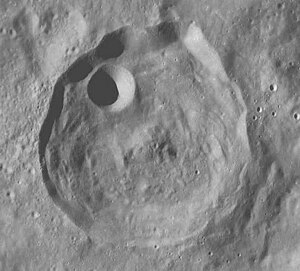Neander (moon crater)
| Neander | ||
|---|---|---|

|
||
| Neander ( LROC -WAC) | ||
|
|
||
| position | 31.38 ° S , 39.9 ° E | |
| diameter | 49 km | |
| depth | 3400 m | |
| Card sheet | 97 (PDF) | |
| Type | TRI | |
| Named after | Michael Neander (1529–1581) | |
| Named since | 1935 | |
| Unless otherwise stated, the information comes from the entry in the IAU / USGS database | ||
Neander is an impact crater to the east of the front of the moon , southeast of Mare Nectaris , southwest of Reichenbach crater and southeast of Piccolomini . The crater is irregularly shaped, moderately eroded and has concentric structures and a central mountain inside .
| Letter | position | diameter | link |
|---|---|---|---|
| A. | 30.98 ° S , 39.58 ° O | 11 km | [1] |
| B. | 28.28 ° S , 40.07 ° E | 9 km | [2] |
| C. | 28.7 ° S , 35.93 ° O | 17 km | [3] |
| D. | 26.59 ° S , 42.4 ° E | 11 km | [4] |
| E. | 29.9 ° S , 40.69 ° E | 25 km | [5] |
| F. | 32.14 ° S , 37.83 ° O | 18 km | [6] |
| G | 33.44 ° S , 43.83 ° E | 18 km | [7] |
| H | 33.09 ° S , 42.46 ° O | 13 km | [8th] |
| J | 34.06 ° S , 43.45 ° O | 14 km | [9] |
| K | 35.04 ° S , 39.76 ° E | 14 km | [10] |
| L. | 31.48 ° S , 41.8 ° E | 21 km | [11] |
| M. | 34.9 ° S , 37.66 ° E | 9 km | [12] |
| N | 32.5 ° S , 37.25 ° E | 15 km | [13] |
| O | 35.67 ° S , 38.94 ° E | 12 km | [14] |
| P | 28.46 ° S , 41.06 ° O | 5 km | [15] |
| Q | 28.93 ° S , 41.45 ° O | 6 km | [16] |
| R. | 33.33 ° S , 38.55 ° E | 12 km | [17] |
| S. | 32.02 ° S , 42.12 ° O | 12 km | [18] |
| T | 29.97 ° S , 38.4 ° E | 9 km | [19] |
| V | 31.27 ° S , 38.06 ° E | 5 km | [20] |
| W. | 32.32 ° S , 38.43 ° O | 7 km | [21] |
| X | 33.07 ° S , 37.75 ° E | 8 kilometers | [22] |
| Y | 34.61 ° S , 38.15 ° O | 8 kilometers | [23] |
| Z | 33.85 ° S , 41.95 ° O | 6 km | [24] |
The crater was officially named by the IAU in 1935 after the German mathematician, philologist and physician Michael Neander .
Web links
- Neander in the Gazetteer of Planetary Nomenclature of the IAU (WGPSN) / USGS
- Neander on The-Moon Wiki
Individual evidence
- ^ John E. Westfall: Atlas of the Lunar Terminator. Cambridge University Press, Cambridge et al. 2000, ISBN 0-521-59002-7 .
